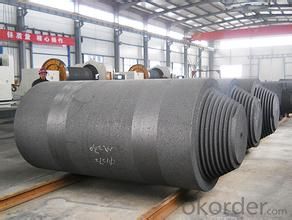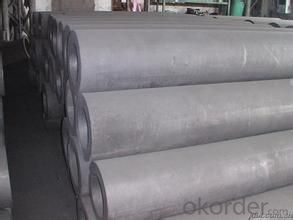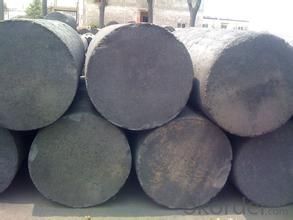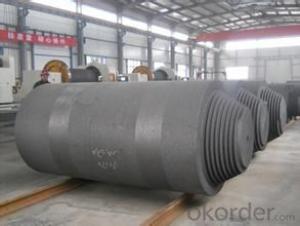Carbon Electrodes with Diameter Φ750~Φ960 RS 38 max
- Loading Port:
- Lianyungang
- Payment Terms:
- TT OR LC
- Min Order Qty:
- 20 m.t.
- Supply Capability:
- 700 m.t./month
OKorder Service Pledge
OKorder Financial Service
You Might Also Like
Spcifications
1:carbon eletrode
2:for ferroalloy,calcium carbide, silicon metal, manufacture
Product Description
Carbon Electrode is abaked electrode used in submerged arc furnaces for delivering power to the charge mix. Electrode is added to the top of the electrode column cylindrical form. Electrode is essentially a mix of Electrically Calcined Anthracite (ECA) or Calcined Petroleum Coke (CPC) with Coal Tar Pitch and is baked for weeks, it is widly used for ferroally productiong, silicon metal production etc.
Graphite/Carbon Electrode Paste Specification:
| PARAMETER UNIT GUARANTEE VALUE | ||||||
| Items | Φ500~Φ700 | Φ750~Φ960 | Φ1020~Φ1400 | |||
| Rs μΩ.m | ≤45 | ≤38 | ≤45 | ≤38 | ≤40 | |
| Bulk Desity g/cm3 | ≥1.55 | ≥1.58 | ≥1.55 | ≥1.58 | ≥1.55 | ≥1.58 |
| Bending Strength MPa | 3.5~7.5 | 4.0~7.5 | 3.5~7.5 | 4.0~7.5 | 3.5~7.5 | 4.0~7.5 |
| Compressive Strength MPa | ≥20.0 | ≥20.0 | ≥20.0 | ≥20.0 | ≥19.0 | ≥19.0 |
| Compressive Strength MPa | 3.2~4.8 | 3.0~4.6 | 3.2~4.8 | 3.0~4.6 | 3.2~4.8 | 3.0~4.6 |
| Ash % | ≤2.5 | ≤2.0 | ≤2.5 | ≤2.0 | ≤2.5 | ≤2.0 |
Picture:




We can adjust the size based on different enquiry. please contact us if you are interested in this materials, we will send our offer as soon as get your kind email.
company information:
China National Building Materials Group is a stated -owned enterprise in charge of administrative affairs in China buiding materials industry.Established in 1984 CNBM is a large group corporation of building materials with total assets of 25 billion and a total stuff of 30000 CNBM now owns 200 subordinating firms of solely owned and joint-venture companies.
- Q:Why carbon 14 can be used to measure the age of matter?
- Libby believes that when plants alive, because continue to carry out photosynthesis, carbon dioxide (including carbon 12 and carbon 14) continue to enter the plant, plant eaten animal, carbon 14 and entering into the body of the animal. The animals and plants 14 carbon content but is constantly changing, Once the plant or animal died, the plant will not absorb carbon dioxide in the atmosphere, the animal will no longer eat plants.
- Q:Does alumina react with carbon?
- NotThe smelting of Al in industry can only be done by electrolysis. Even at high temperatures, the reducibility of C is not as strong as Al, and the melting point of Al2O3 is very high. At this temperature, C has been gasified
- Q:What is the carbon content of different types of household waste?
- The carbon content of various household waste types can differ based on the specific materials being disposed of. Generally, organic waste, including food scraps, yard waste, and paper products, tends to have higher carbon content when compared to inorganic waste like glass, plastics, and metals. Food waste consists mainly of organic materials and possesses a significant carbon content, typically ranging from 50 to 70 percent. This is because food originates from plants and animals, which contain carbon-rich carbohydrates, proteins, and fats. Yard waste, such as grass clippings, leaves, and branches, also contains a substantial amount of carbon. It is composed of plant matter predominantly made up of carbon-based compounds like cellulose and lignin. The carbon content of yard waste can vary depending on the vegetation type, but it generally falls between 40 to 60 percent. Paper products, such as newspapers, cardboard, and office paper, are primarily manufactured from wood pulp. Wood consists of carbon-containing compounds like cellulose, hemicellulose, and lignin. Consequently, paper waste possesses a notable carbon content, typically ranging from 40 to 60 percent. On the other hand, inorganic waste materials like glass, plastics, and metals have minimal carbon content. These materials are mainly derived from non-renewable resources such as minerals and fossil fuels, which have low carbon content. As a result, their carbon content is negligible or close to zero. It is crucial to acknowledge that while organic waste contains higher carbon content, it also holds the potential for composting or conversion into biogas through anaerobic digestion, thereby contributing to carbon sequestration or renewable energy generation. In contrast, inorganic waste materials like plastics and metals are non-biodegradable and can have harmful environmental consequences if not managed properly.
- Q:Is carbon monoxide good for people?
- No good, generally will cause poisoning, gas poisoning is actually carbon monoxide poisoning
- Q:What are the different types of carbon-based inks?
- A variety of carbon-based inks are commonly utilized in different applications. One category is carbon black ink, produced by burning organic substances like wood or petroleum products in a low-oxygen environment. This ink is renowned for its deep black hue and is frequently employed in printing and calligraphy. Another kind is carbon nanotube ink, created by dispersing carbon nanotubes in a liquid medium. Carbon nanotubes are minuscule cylindrical structures composed of carbon atoms, and their distinctive electronic properties make them valuable in applications such as flexible electronics and energy storage devices. There is also graphene ink, made by dispersing graphene flakes in a liquid medium. Graphene consists of a single layer of carbon atoms arranged in a hexagonal pattern, and it possesses remarkable strength, electrical conductivity, and flexibility. Graphene ink is utilized in various applications, including flexible electronics, sensors, and batteries. Furthermore, conductive carbon-based inks are employed in electronics and circuitry. These inks usually contain a combination of carbon particles and a binding material, and they are used to create conductive pathways on substrates like paper or plastic. Overall, carbon-based inks offer a vast array of possibilities due to the unique properties of carbon materials. They find applications in diverse fields, including printing, calligraphy, electronics, energy storage, and more.
- Q:What are the properties of carbon nanotubes?
- Carbon nanotubes are cylindrical structures made entirely of carbon atoms. They have a unique set of properties that make them highly desirable in various fields of science and technology. Some of the key properties of carbon nanotubes include: 1. Exceptional strength and stiffness: Carbon nanotubes have an incredibly high strength-to-weight ratio, making them one of the strongest materials known to date. They are about 100 times stronger than steel but much lighter. This property makes them suitable for applications requiring lightweight but strong materials. 2. High electrical conductivity: Carbon nanotubes possess excellent electrical conductivity, allowing them to efficiently carry electrical current. They can be utilized as conductive components in various electronic devices, such as transistors, sensors, and energy storage systems. 3. Thermal conductivity: Carbon nanotubes exhibit high thermal conductivity, meaning they can efficiently conduct heat. This property makes them ideal for applications requiring efficient heat dissipation, such as thermal management in electronic devices. 4. Flexibility and resilience: Carbon nanotubes are highly flexible and can withstand significant deformation without breaking. They can be bent and twisted without losing their structural integrity, making them suitable for applications requiring flexibility, such as flexible electronics. 5. Unique optical and mechanical properties: Carbon nanotubes possess unique optical properties that vary depending on their structure and arrangement. They can absorb and emit light across a wide range of wavelengths, making them useful in applications like photodetectors and solar cells. Additionally, their mechanical properties, such as the ability to deform elastically, make them useful in applications requiring shock absorption and impact resistance. 6. Chemical stability: Carbon nanotubes are highly chemically stable, which means they can resist degradation or corrosion when exposed to various chemical environments. This property makes them suitable for applications in harsh conditions or as protective coatings. 7. Large aspect ratio: Carbon nanotubes have a high aspect ratio, with lengths often exceeding thousands of times their diameter. This characteristic allows them to form strong and lightweight composite materials when incorporated into a matrix, enhancing the overall strength and stiffness of the composite. Overall, the unique combination of properties exhibited by carbon nanotubes makes them an exciting and versatile material with immense potential for a wide range of applications, including electronics, aerospace, medicine, and energy storage.
- Q:What are the 3K, 12K, UD, etc. in the appearance requirements of the carbon fiber bicycle? What's the difference?
- 3K 12K UD refers to the pattern of carbon fiber thickness, 3K pattern is the smallest of the above lattice minimum.The higher the number of K, the more tedious the process, the more expensive the cost, but unfortunately, the performance of large pieces of no help, just to meet psychological needs. The smaller the carbon fiber object, the smaller the grid, so that the force is better. The carbon fiber component of the remote control helicopter is the 3K pattern. My 12K version is on ArchitectureThere are some people say: UD carbon cloth is like carbon cloth, and there is a gap between the strength of carbon cloth, 3K carbon cloth is made of 3 thousand carbon fiber woven cloth, UD imitation carbon cloth is formed in parallel with carbon fiber tile free carbon cloth, and then cut into UD imitation carbon cloth needs finally, to make the same width, Zhumie into UD.
- Q:How do plants and trees absorb carbon dioxide?
- Through photosynthesis, plants and trees engage in a process known as carbon dioxide absorption. This process entails the conversion of sunlight, water, and carbon dioxide into glucose and oxygen. Within the plant cells, this transformation occurs in specialized structures called chloroplasts. During photosynthesis, plants absorb carbon dioxide from the atmosphere via small openings on their leaves called stomata. The carbon dioxide then infiltrates the plant's cells and travels to the chloroplasts. Within these chloroplasts, the energy from sunlight is utilized to convert the carbon dioxide and water into glucose and oxygen. The glucose generated through photosynthesis serves as a vital energy source for the plant's growth, reproduction, and other metabolic activities. Some of this glucose is stored as starch within the plant, while the remainder is used to produce other crucial compounds. The oxygen produced during photosynthesis is subsequently released back into the atmosphere through the stomata. This oxygen is indispensable for the survival of various animals, including humans, as it is necessary for respiration. In essence, the absorption of carbon dioxide through photosynthesis is an essential function performed by plants and trees. They function as natural carbon sinks, playing a vital role in regulating the levels of this greenhouse gas and mitigating the impacts of climate change.
- Q:How does carbon affect the formation of acidification in lakes?
- Lakes undergo acidification due to the significant role played by carbon dioxide (CO2). Human activities, such as burning fossil fuels, release carbon dioxide into the atmosphere. This carbon dioxide can then be absorbed by lakes, resulting in the formation of carbonic acid (H2CO3), a weak acid. When carbonic acid interacts with water, it dissociates into hydrogen ions (H+) and bicarbonate ions (HCO3-). The increase in hydrogen ions causes a decrease in pH levels, making the water more acidic. This process is commonly referred to as acidification. The acidification of lakes can have detrimental effects on aquatic ecosystems. It negatively impacts the physiology and behavior of various species, including fish, amphibians, and invertebrates. Furthermore, the eggs and larvae of these organisms can be damaged by acidic waters, hindering their growth and survival. Acidification also has the potential to disrupt the composition and abundance of phytoplankton, which are vital for maintaining the overall health of the ecosystem. Additionally, high levels of acidity can result in the leaching of toxic metals, such as aluminum, from the surrounding soil and rocks. These toxic metals then dissolve in the water, posing an additional threat to aquatic organisms. Acidification can also disrupt the nutrient cycles in lakes, ultimately affecting the availability of essential nutrients for plants and animals. To summarize, the presence of carbon dioxide in the atmosphere contributes to the acidification of lakes when it is absorbed by water. This acidification has a range of negative impacts on the aquatic ecosystem, including altered physiology, impaired reproduction, and disrupted nutrient cycles. It is imperative to reduce carbon emissions and mitigate the effects of acidification to safeguard the health and diversity of lake ecosystems.
- Q:How does carbon dioxide affect the formation of smog?
- Carbon dioxide (CO2) does not directly contribute to the formation of smog. Smog is primarily formed by the interaction of sunlight with other pollutants such as nitrogen oxides (NOx) and volatile organic compounds (VOCs). These pollutants are emitted from various sources including vehicles, industrial processes, and power plants. However, while carbon dioxide does not directly participate in smog formation, it does play a significant role in contributing to climate change. CO2 is a greenhouse gas, meaning it traps heat in the Earth's atmosphere and contributes to the warming of the planet. As the Earth warms, it can lead to changes in weather patterns, resulting in more stagnant air conditions that can exacerbate smog formation. Additionally, the burning of fossil fuels, which releases carbon dioxide, is a major source of air pollutants like NOx and VOCs. So while CO2 itself may not directly contribute to smog formation, the activities that release CO2 can indirectly contribute to smog by releasing other pollutants that are involved in its formation. Therefore, the impact of carbon dioxide on smog formation is indirect, primarily through its contribution to climate change and the release of other pollutants. Reducing carbon dioxide emissions and transitioning to cleaner energy sources can help mitigate climate change and indirectly reduce the factors that contribute to smog formation.
1. Manufacturer Overview |
|
|---|---|
| Location | |
| Year Established | |
| Annual Output Value | |
| Main Markets | |
| Company Certifications | |
2. Manufacturer Certificates |
|
|---|---|
| a) Certification Name | |
| Range | |
| Reference | |
| Validity Period | |
3. Manufacturer Capability |
|
|---|---|
| a)Trade Capacity | |
| Nearest Port | |
| Export Percentage | |
| No.of Employees in Trade Department | |
| Language Spoken: | |
| b)Factory Information | |
| Factory Size: | |
| No. of Production Lines | |
| Contract Manufacturing | |
| Product Price Range | |
Send your message to us
Carbon Electrodes with Diameter Φ750~Φ960 RS 38 max
- Loading Port:
- Lianyungang
- Payment Terms:
- TT OR LC
- Min Order Qty:
- 20 m.t.
- Supply Capability:
- 700 m.t./month
OKorder Service Pledge
OKorder Financial Service
Similar products
New products
Hot products






























